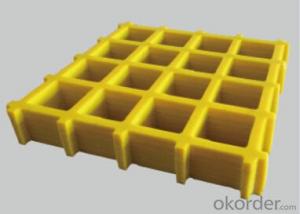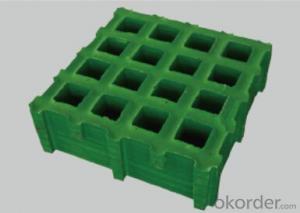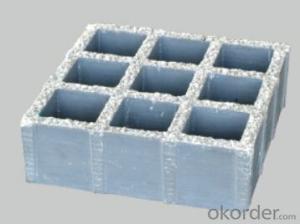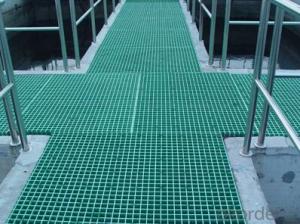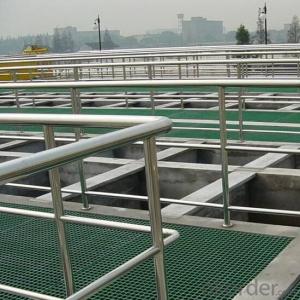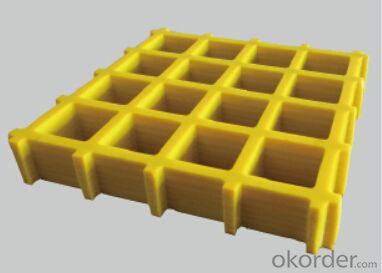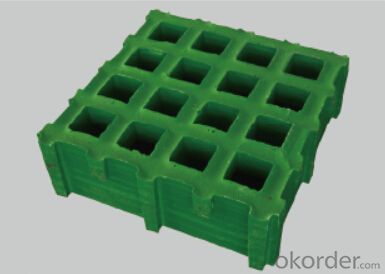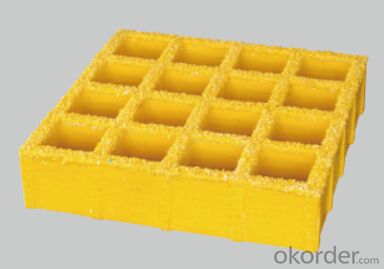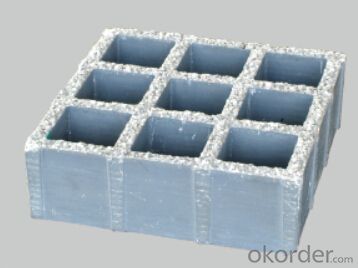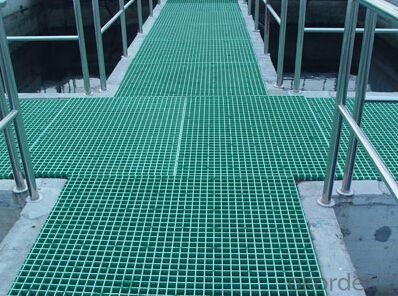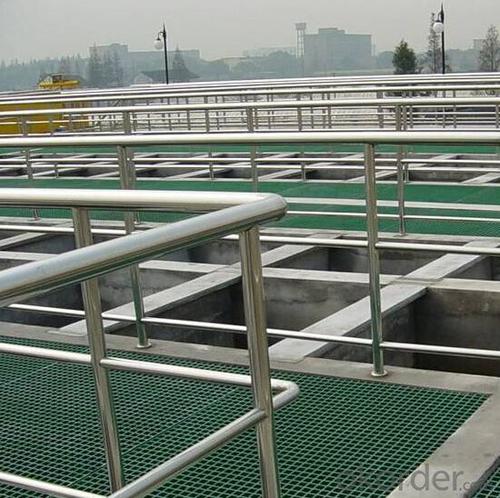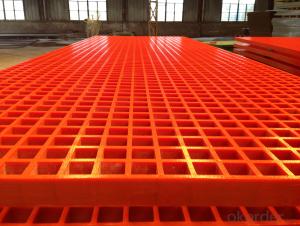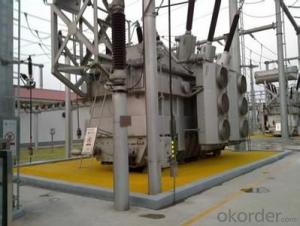High-Quality FRP Pultrusion Profiles for Sewage Pool Grating
- Loading Port:
- Shanghai
- Payment Terms:
- TT OR LC
- Min Order Qty:
- 10 pc
- Supply Capability:
- 8000 pc/month
OKorder Service Pledge
OKorder Financial Service
You Might Also Like
Specification:
FRP molded grating made of vertical and horizontal continuous fiberglass fully soaked in unsaturated polyester resin giving perfect bi-directional mechanical properties. Combining unmatched corrosion resistance with strength, long life and safety, molded grating provide the ultimate in reliable performance, even in the most demanding corrosive conditions. Besides, it is easy to cut and install. CNBM offer the widest selection with panel sizes, colors and slip resistant surfaces, clients can avail FRP grating your specific requirements.
Product Features:
- Light but high loaded strength
- High anti-corrosion and anti-aging
- Easy installation and maintenance
- Low maintenance
- Non-conductive
- Lowest in life cycle cost
- Corrosion Resstance
- Anti-slippery
- Various sizes and color available
Colour Design:
To satisfy customer's design project, CNBM grating offers a wide selection of grating colors to choose from. The standard colors available for fiberglass grating as following:
- Blue
- Red
- Yellow
- Green
- Light Grey
- Dark Grey
Custom colors of fiberglass grating may be available upon request, you can contact us learn more.
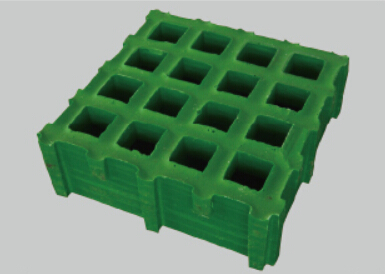
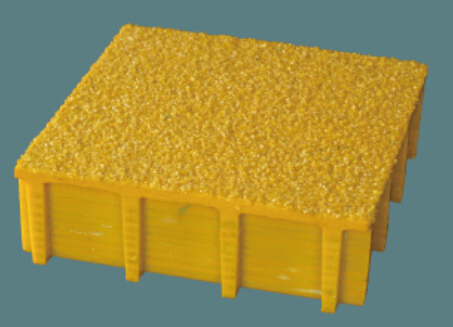
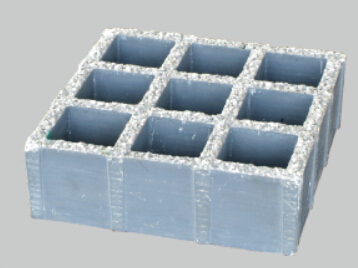
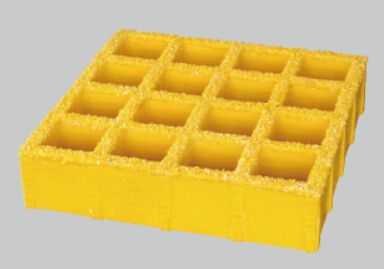
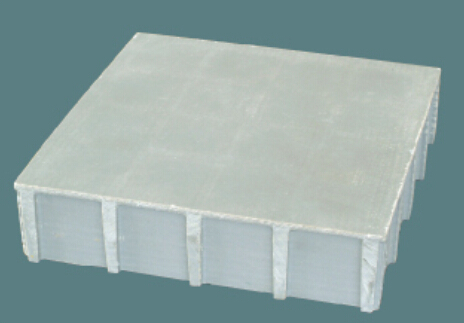
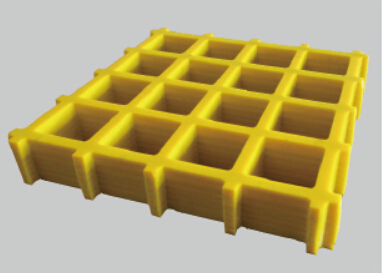
- Q: Are FRP pultrusion profiles resistant to high-pressure water jets?
- FRP pultrusion profiles have a general resistance to high-pressure water jets. Their high strength-to-weight ratio, corrosion resistance, and durability make them suitable for applications involving water and harsh environments. The pultrusion manufacturing process ensures thorough resin impregnation of the fibers, resulting in a dense composite material. This density provides high resistance to water penetration, protecting the material from damage by high-pressure water jets. Additionally, FRP pultrusion profiles exhibit excellent chemical resistance, including resistance to water. This ensures that the profiles will not degrade when exposed to high-pressure water jets for extended periods. It is important to note that the specific resistance of FRP pultrusion profiles to high-pressure water jets may vary depending on the resin and fiber combination used. To obtain detailed information about the resistance of specific profiles in a given application, it is recommended to consult the manufacturer or supplier.
- Q: Can FRP pultrusion profiles be used in infrastructure projects?
- Yes, FRP (Fiber Reinforced Polymer) pultrusion profiles can be used in infrastructure projects. FRP pultrusion profiles offer several advantages over traditional materials such as steel and concrete. Firstly, FRP profiles are lightweight, yet still possess high strength-to-weight ratios. This makes them easier to transport and install, reducing construction time and costs. Additionally, their lightweight nature ensures they do not exert excessive loads on the supporting structures. Secondly, FRP profiles are corrosion-resistant. Unlike steel, FRP does not rust or corrode when exposed to harsh environmental conditions, making them ideal for infrastructure projects located in coastal areas or regions with high humidity. This corrosion resistance extends the service life of the structures and reduces maintenance requirements, resulting in long-term cost savings. Thirdly, FRP pultrusion profiles offer excellent durability and dimensional stability. They are highly resistant to fatigue, creep, and environmental degradation, ensuring the longevity and structural integrity of the infrastructure. Their dimensional stability also means that they maintain their shape and structural properties over time, reducing the risk of deformation or failure. Furthermore, FRP profiles can be customized to meet specific project requirements. They can be manufactured in various shapes, sizes, and strengths, allowing for versatile applications in infrastructure projects such as bridges, walkways, railings, support structures, and utility poles. Overall, the use of FRP pultrusion profiles in infrastructure projects offers numerous advantages, including lightweight construction, corrosion resistance, durability, and customization options. These benefits make FRP profiles a viable and cost-effective alternative to traditional materials for various infrastructure applications.
- Q: What are the quality control measures for FRP pultrusion profiles?
- To ensure the desired standards are met, a series of steps and processes are involved in quality control measures for FRP pultrusion profiles. These measures encompass: 1. Inspection of raw materials: The initial step involves verifying the quality of the raw materials used in the pultrusion process. This entails assessing the properties and specifications of components such as fiberglass, resin, additives, and others. 2. Control of the process: Throughout the pultrusion process, it is crucial to monitor and control various parameters. This includes maintaining consistent temperature, pressure, and resin content during impregnation, forming, and curing stages. 3. Testing of samples: Regular sampling is conducted during production to evaluate profile quality. Mechanical properties, dimensional accuracy, and surface finish are tested to ensure they align with the required standards. 4. Visual examination: Each profile undergoes visual inspection to identify any defects, such as cracks, voids, delamination, or surface imperfections. This examination aids in detecting irregularities that may impact the profiles' structural integrity or aesthetics. 5. Mechanical assessment: Profiles are subjected to mechanical testing to evaluate strength, stiffness, and other mechanical properties. Flexural, tensile, impact, and compression tests are conducted, comparing the results to specified requirements to determine compliance with necessary standards. 6. Documentation of quality: Proper documentation is maintained throughout the manufacturing process, encompassing records of raw material specifications, process parameters, test results, and inspection reports. This ensures traceability and serves as a reference for quality assurance. 7. Non-destructive testing: In addition to mechanical testing, non-destructive techniques like ultrasonic testing or X-ray inspection may be employed to identify internal defects or inconsistencies without causing damage to the profiles. 8. Quality audits: Regular internal and external audits are performed to evaluate the effectiveness of quality control measures and ensure adherence to relevant industry standards and regulations. By incorporating these quality control measures, manufacturers can guarantee that FRP pultrusion profiles meet the necessary specifications, resulting in dependable and high-quality products.
- Q: Can FRP pultrusion profiles be used in telecommunications towers?
- Telecommunications towers can indeed utilize FRP (Fiber Reinforced Polymer) pultrusion profiles. These profiles possess several advantageous features that render them suitable for this particular application. Firstly, FRP profiles possess a lightweight yet robust nature, facilitating effortless installation and reducing the overall structural weight of telecommunications towers. This characteristic is crucial as it aids in minimizing the burden imposed on the tower structure. Secondly, FRP pultrusion profiles exhibit exceptional resistance to corrosion, making them ideally suited for outdoor applications such as telecommunications towers that are constantly exposed to diverse environmental conditions. Unlike conventional materials like steel or wood, FRP profiles do not succumb to rust, rot, or deterioration when subjected to moisture, UV radiation, or chemicals typically encountered in outdoor environments. Additionally, FRP pultrusion profiles offer excellent electrical insulation properties, a critical aspect for telecommunications towers. These profiles are non-conductive, thereby reducing the likelihood of electrical interference or short circuits that might disrupt the tower's communication systems. Moreover, FRP pultrusion profiles can be produced in various shapes and sizes, thereby enabling customization and meeting the specific design requirements of telecommunications towers. This versatility facilitates seamless integration and compatibility with other components of the tower. Overall, the combination of lightweight composition, high strength, corrosion resistance, electrical insulation, and customization options renders FRP pultrusion profiles an advantageous and viable selection for utilization in telecommunications towers.
- Q: Can FRP pultrusion profiles be used in renewable energy projects?
- Certainly, FRP pultrusion profiles are capable of being used in renewable energy projects. They possess a wide range of advantages that make them suitable for various applications within the renewable energy sector. To begin with, FRP pultrusion profiles are both lightweight and strong, which makes them ideal for utilization in wind turbine blades. The lightweight nature of FRP materials allows for increased efficiency in wind energy generation by reducing the load on the turbine, thus enhancing overall performance. Furthermore, the high strength-to-weight ratio of FRP profiles ensures durability and longevity, even in severe environmental conditions. Additionally, FRP pultrusion profiles display exceptional resistance to corrosion, which renders them suitable for employment in solar panel mounting structures and other components exposed to moisture and outdoor elements. This corrosion resistance ensures that FRP profiles maintain their structural integrity and performance over an extended period, diminishing the need for frequent maintenance and replacement. Furthermore, FRP pultrusion profiles can be customized to meet specific project requirements, providing flexibility in design and functionality. They can be easily molded into complex shapes and sizes, facilitating the creation of innovative and efficient solutions for renewable energy projects. Moreover, FRP materials are non-conductive and possess excellent electrical insulation properties, making them suitable for use in electrical enclosures and support structures for renewable energy systems such as solar power plants. In conclusion, FRP pultrusion profiles can be effectively utilized in renewable energy projects due to their lightweight, strong, corrosion-resistant, customizable, and electrically-insulating properties. These characteristics make FRP profiles a reliable and sustainable choice for various applications within the renewable energy sector.
- Q: Do FRP pultrusion profiles require any special tools for installation?
- Yes, FRP pultrusion profiles do require special tools for installation. These tools typically include saws for cutting the profiles to size, drills for creating holes, and adhesive application tools for bonding the profiles to the substrate. Additionally, specialized fasteners and brackets may be needed to secure the profiles in place. It is important to use these tools correctly to ensure a proper and secure installation of FRP pultrusion profiles.
- Q: Can FRP pultrusion profiles be used in automotive applications?
- Yes, FRP (Fiber Reinforced Polymer) pultrusion profiles can be used in automotive applications. FRP pultrusion profiles offer several advantages that make them suitable for automotive use. Firstly, FRP pultrusion profiles are lightweight yet strong, which is crucial in the automotive industry where reducing weight is a priority for improving fuel efficiency and performance. The high strength-to-weight ratio of FRP profiles allows for the design of lighter and more fuel-efficient vehicles. Secondly, FRP pultrusion profiles possess excellent corrosion resistance, which is important for automotive applications where exposure to various chemicals, moisture, and harsh environments is common. This resistance to corrosion ensures the long-term durability and reliability of the profiles, reducing maintenance costs and increasing the lifespan of automotive components. Additionally, FRP pultrusion profiles offer design flexibility, enabling the creation of complex shapes and geometries that can be customized to meet specific automotive requirements. This flexibility allows for the integration of FRP profiles in various automotive components, such as body panels, structural supports, interior trims, and suspension parts. Furthermore, FRP pultrusion profiles exhibit high fatigue resistance, which is crucial for automotive applications that involve repetitive loading and vibrations. The fatigue resistance of FRP profiles ensures their long-term performance and helps prevent failures and breakdowns. Lastly, FRP pultrusion profiles are electrically non-conductive, which is beneficial for automotive applications where electrical isolation is required. This property eliminates the need for additional insulation and reduces the risk of electrical failures and short circuits. Overall, the combination of lightweight, high strength, corrosion resistance, design flexibility, fatigue resistance, and electrical non-conductivity makes FRP pultrusion profiles suitable for various automotive applications, contributing to improved performance, fuel efficiency, durability, and safety in the automotive industry.
- Q: Can FRP pultrusion profiles be used in the construction of theme park rides?
- Theme park rides can indeed incorporate FRP (Fiber Reinforced Polymer) pultrusion profiles. These profiles possess various advantages that make them suitable for this purpose. First and foremost, FRP pultrusion profiles possess a combination of lightness and strength, rendering them ideal for constructing ride structures that must endure dynamic loads and forces. Their remarkable strength-to-weight ratio enables the creation of intricate, sizable structures capable of supporting the weight of riders and withstanding the forces generated during operation. Moreover, FRP pultrusion profiles exhibit corrosion resistance, a crucial characteristic for theme park rides frequently exposed to outdoor environments, including moisture, chemicals, and UV radiation. This corrosion resistance ensures the durability and safety of the ride structures throughout their lifespan, reducing the need for costly maintenance and repairs. Another advantage of FRP pultrusion profiles lies in their design flexibility. They can be easily shaped and sized to meet the unique requirements of theme park ride designs. This versatility allows for the creation of distinctive, visually appealing ride structures that enhance the overall experience for park visitors. Furthermore, FRP pultrusion profiles possess excellent electrical insulation properties, particularly valuable for rides involving electrical components or systems. This insulation effectively minimizes the risk of electrical hazards, ensuring the safety of riders and operators. In conclusion, FRP pultrusion profiles are an excellent choice for constructing theme park rides due to their lightweight nature, high strength, corrosion resistance, design flexibility, and electrical insulation properties. By incorporating these profiles, safe, durable, and visually captivating ride structures can be developed, enhancing the enjoyment and excitement of theme park visitors.
- Q: Are FRP pultrusion profiles resistant to oil or fuel spills?
- Yes, FRP (Fiber Reinforced Polymer) pultrusion profiles are generally resistant to oil or fuel spills. FRP is known for its excellent resistance to a wide range of chemicals, including oils and fuels. The combination of the polymer resin and the reinforcing fibers provides a strong and durable material that can withstand exposure to various substances. FRP pultrusion profiles have a non-porous surface, which makes them impermeable to oil and fuel. This means that even if there is a spill, the profiles will not absorb the substances, preventing any potential damage or degradation. Additionally, FRP is resistant to corrosion and does not react with oils or fuels, ensuring its long-term performance and durability. Due to these properties, FRP pultrusion profiles are commonly used in industries where oil or fuel spills are a concern, such as in oil refineries, chemical plants, and offshore platforms. They offer a reliable solution for applications that require resistance to chemical exposure, providing a cost-effective and low-maintenance alternative to traditional materials.
- Q: Are FRP pultrusion profiles resistant to chemical spills or leaks?
- Yes, FRP (Fiber Reinforced Polymer) pultrusion profiles are highly resistant to chemical spills or leaks. The combination of the fiberglass reinforcement and the polymer matrix used in FRP pultrusion provides excellent resistance to a wide range of chemicals, acids, and corrosive substances. This makes FRP pultrusion profiles a suitable choice for applications where chemical resistance is crucial, such as in chemical processing plants, wastewater treatment facilities, and storage tanks.
Send your message to us
High-Quality FRP Pultrusion Profiles for Sewage Pool Grating
- Loading Port:
- Shanghai
- Payment Terms:
- TT OR LC
- Min Order Qty:
- 10 pc
- Supply Capability:
- 8000 pc/month
OKorder Service Pledge
OKorder Financial Service
Similar products
Hot products
Hot Searches
Related keywords
